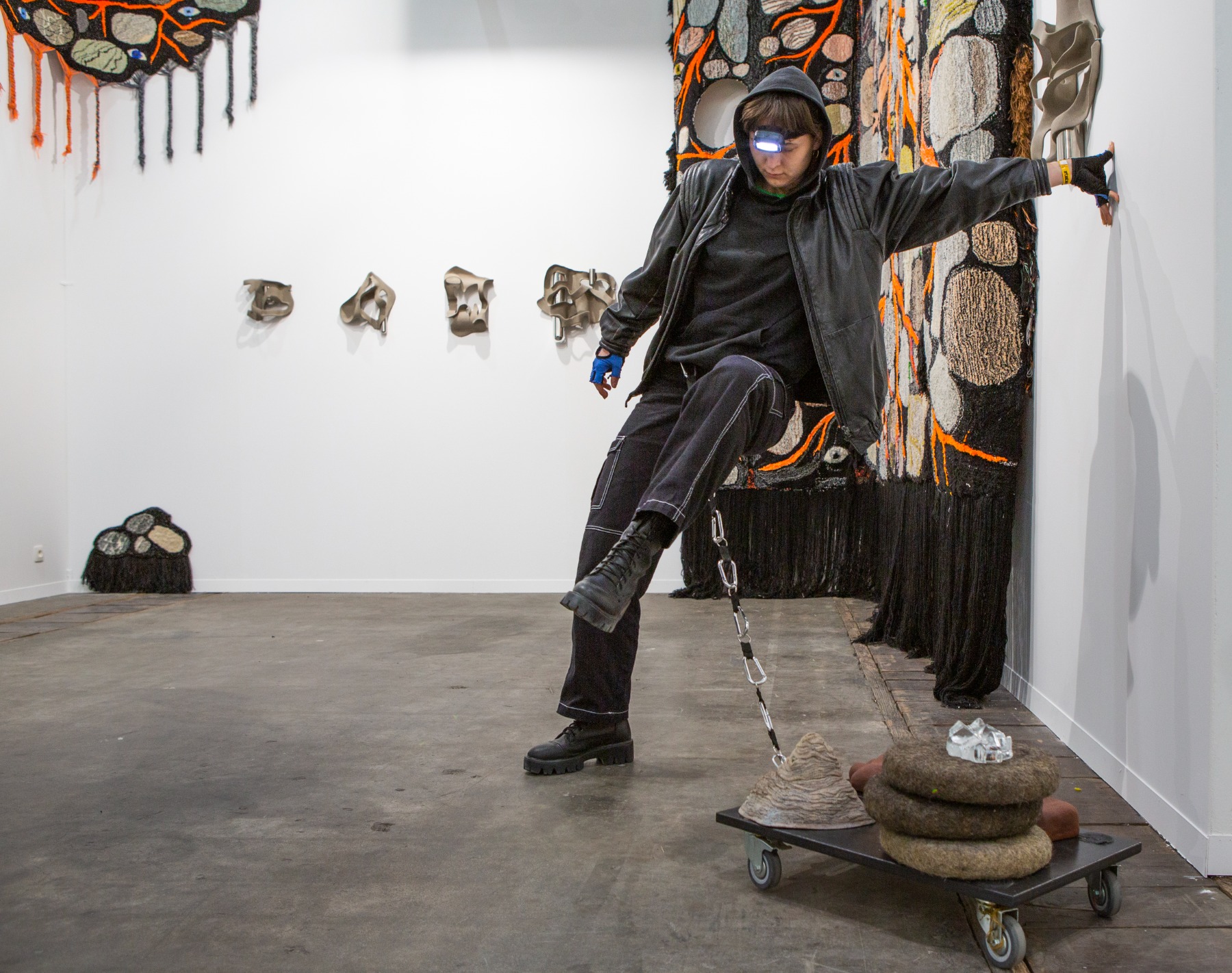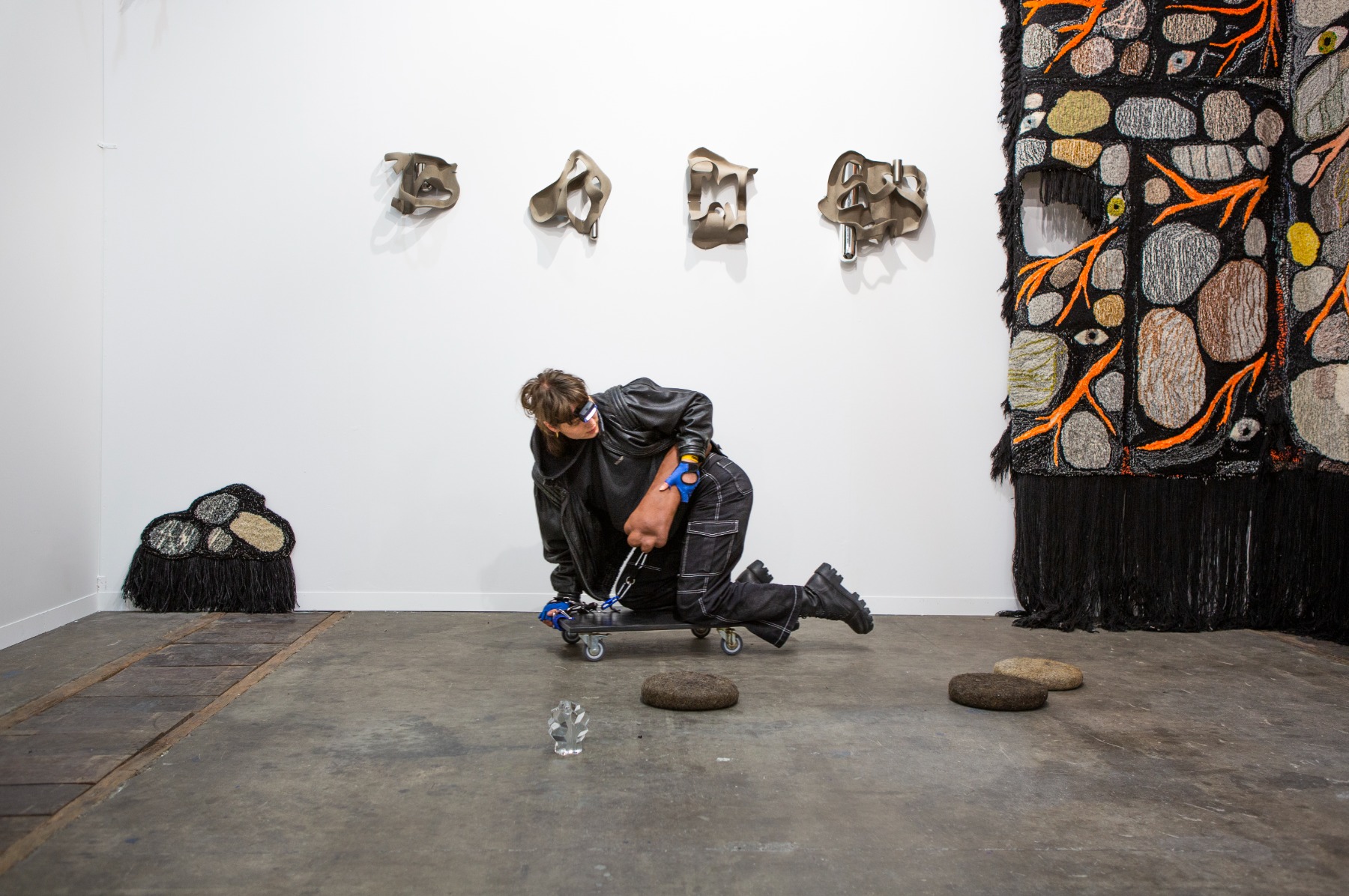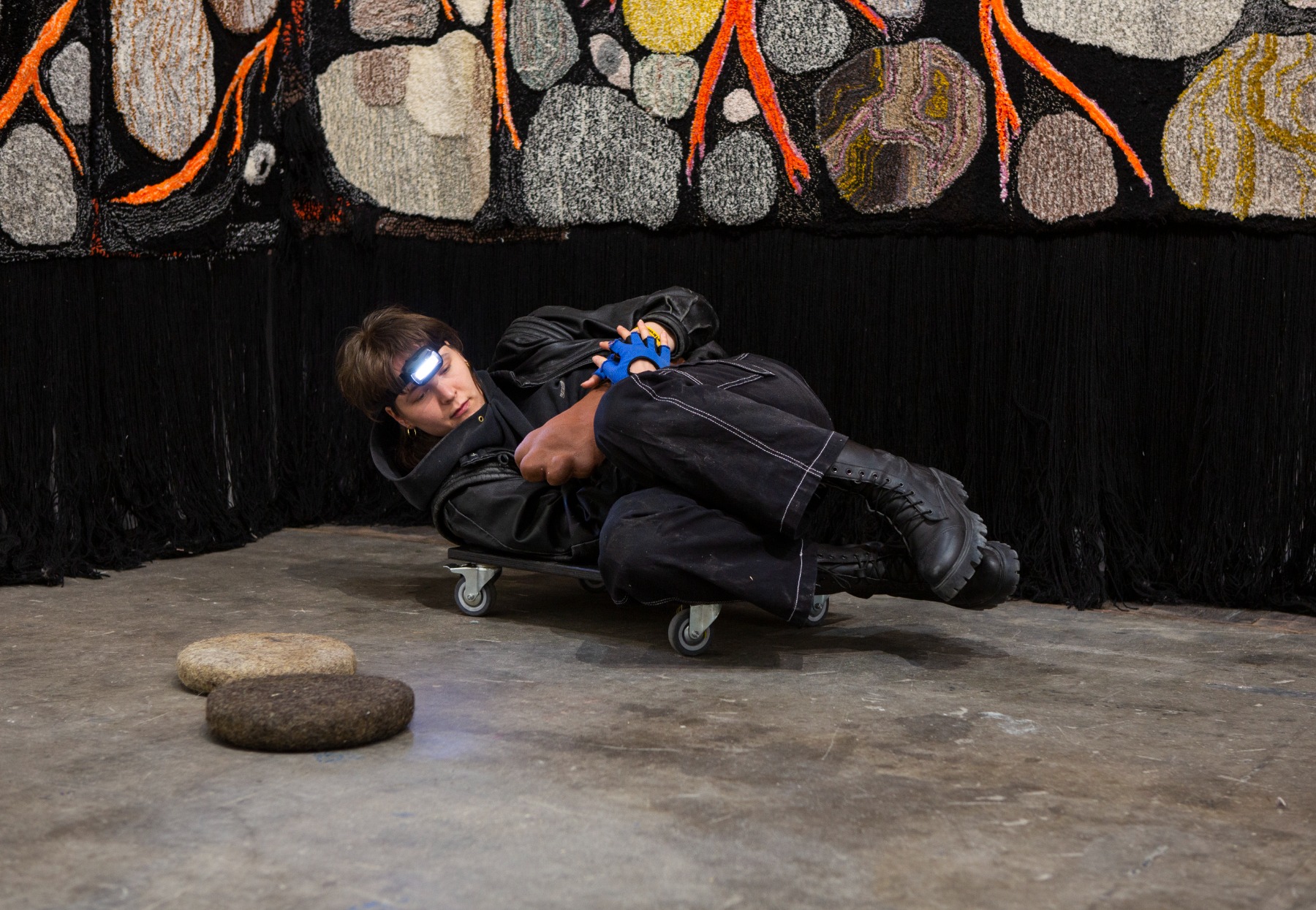
The sweet taste of a hint, to encounter
Laura De Jaeger
Laura Põld with Kogo Gallery at Art Brussels 2023
With the last of the April Showers (in one of the local languages aprilse grillen, literally translated April’s moods, caprices or even quirks) the 39th edition of Art Brussels took place. More than 150 galleries and artists presented a selection of works. This year, the fair returned from the city centre to the Art Deco inspired hall 5 and 6 at Brussels Expo.

Art fairs push through the soil like mushrooms after late-August showers, in a similar way to art biennials. In Brussels, however, the fair has existed since 1968, and recently celebrated its half-century. As a young artist, I would dare to say that such an art event is ever-dependant on the mood. One’s eagerness on that specific day to interact with the artworks as well as the art community, or to invest in both. Aprily. This fair’s focus on discovery gives a breath of fresh air to a challenging format for experiencing art. Among the jungle of booths, one can, for the first time, find a young gallery from Tartu. I will walk through the notion of an art fair and its possible characteristics via the endearing work of artist Laura Põld, represented by Kogo Gallery.
Kogo Gallery at Art Brussels 2023. Photo: Lucie Deluz
To encounter
One could argue that to exhibit is an essential part of an art practice. First, there is a time for creation. A maker shapes, waits, then remakes. They cut, pause and stitch together. They wait some more, to again add, select and reconfigure. It’s hard to pinpoint this exact trajectory. No list, recipe, YouTube/Tiktok how-to or CoStar app can precisely predict the process. Even for the person themselves it’s a never-ending challenge! I’m not talking about the genius image of an artist, who follows a mysterious flow that only few of us possess. I point to a genuine person on a search, in deep dialogue with the material and their surroundings. The dialogue is ever changing and it is hard to foretell where it might go. Anyhow, whenever and however they arrive at a final point, the work can then be exhibited to the outsider’s eye. Whether an artist is considered an artist without ever presenting work is debatable, but often, one way or another, the artwork is presented to the public.
The meeting of an artwork and the outsider’s eye (and body!) can take place anywhere, any time. One of these places can be as peculiar as an art fair. I highlight its oddities because to present personal, intuitive discourses that have been accumulated in a commercial context is always a bit bizarre. Last time I worked on a fair was about 6 years ago, a boat fair. In essence, a fair is a gathering of buyers and sellers at a particular time or place. One can call it a centre of trade. There is a sense of spectacle to a fair (and well, art can also contain a spectacle). Some definitions would emphasise that a fair is a competitive exhibition. This aligns more with the vocabulary we are acquainted with.
Kogo Gallery at Art Brussels 2023. Photo: Lucie Deluz
The practice of exhibiting appears anywhere, even in daily life. I mean, I can curate my wardrobe. People exhibit when they bring something to the public eye. Art Brussels, as with any art fair, is not comparable to a classical exhibition format we are used to seeing art, such as galleries or institutions. This is because a fair is a place for introductions, or first encounters.
Visitors are introduced to the artistic discourse of Laura Põld via a monumental piece on the wall. This textile work, created with a tuft gun, has had a former life. It used to be part of the set design for a theatre production. To me, the piece exemplifies the artist’s interest in tactility and direct connection between hand and material. The piece depicts bright orange roots. They almost scream at me, as lightning bolts that strike. An enormous number of eyes are spread throughout the whole composition. Those eyes literally gaze back at me. I find myself stunned by how my eyesight can experience tactility. It is as if the artist connects my vision to my fingertips, softly moving me along the edges of threat. Various textile pieces surround me. Like soft clouds, playfully positioned in space, they embrace me. But the comfort is rather active, as their imagery is on the verge of eeriness. The work peeks at me through the darkness. This combination of closeness and spookiness makes me think about storytelling and folklore, a genre which is clearly present in Põld’s creative language.
The practice of encountering always contains a first impression. In a hall full of gallery booths, first impressions can be essential. I find a gallery presenting the work of Melanie Bonajo. Bonajo represented the Netherlands with a similar immersive installation last year at La Biennale di Venezia. A practice which is already burned in my retina works like an eye-catcher and is easy to remember. Clever! Galerie Greta Meert, a renowned Brussels-based gallery, presents several works by the father of Minimalism Donald Judd. When galleries, as young and ambitious as Kogo, aim to focus on reflective, experimental and research-based practices, I feel hopeful for the field. To prioritise questions over economics, the growth of the field over that of capital, feels as if we are looking towards the future. Cultural value is anyhow often created in retrospect.
Kogo Gallery at Art Brussels 2023 / performance by Sigrid Savi. Photo: Lucie Deluz
To stroll by
It is of importance during the experience of the fair to keep pace. A visitor strolls around as much as he stands still. Is it comparable to speed-dating? Meeting one work after another, I tend to enjoy the stroll. It is my own personal space between encounters, a place where I have time to connect. I spin my web, weave my scarf and start to understand certain tendencies in contemporary art today. I find myself looking for indicators of new shamanism or new materialism, and how they differ from booth to booth. I discover the relationship Belgium has with the medium of painting and rediscover those Benelux aesthetics people keep referring to.
Art Brussels created a framework for my walk, dividing the galleries into various sections. Prime contains galleries that focus on established artists, whereas the Discovery section brings together young, emerging artists with recent works. With Rediscovery, the fair dedicates a category to art from the 20th century by artists (living or deceased) that might have been forgotten, underrated or underestimated. Solo is the fair’s longing for in-depth focus, gathering galleries that highlight one artist.
Kogo Gallery at Art Brussels 2023 / performance by Sigrid Savi. Photo: Lucie Deluz
Another exploratory walk happens inside the Kogo booth. In between the works by Laura Põld, contemporary dancer Sigrid Savi regularly makes her own tour. She interacts with a selection of materials. Collected on a small carriage, they accompany her on her journey, and together they remind me of a dog on a leash. The objects are carefully chosen from Põld’s studio. I distinguish several round pillows made of felt, a glass structure and even (what seems to be) a dog’s paw made out of clay. What distinguishes Savi from other visitors are her sporty gloves and headlamp. The performer’s movement emphasizes the immaterial and invisible cavities a fair booth could have. Throughout this abstract, exploratory movement, she carefully distributes the objects in the space. Savi relates to them as if they are precious, historical objects. Not in the collective sense of the word, but on a personal, private level. I notice qualities such as care and connection in her movement. The most gentle moment is when the dog paw ends up caressing the pillow. While connecting and reconnecting with each object, the performer is mostly on the move. Where Põld’s stones and caves are steady, firm objects, Sigrid Savi creates contrast with a movement-based practice, outfit, and attributes.
Savi’s spelunking elaborates on a series of smaller works presented by Laura Põld at the fair. These objects gain attention through their materiality: they resemble both stone and felt. Essentially, they are stoneware, high fired ceramics which were left unglazed and then thoroughly sanded. The works are inspired by a number of French caves Põld visited during a residency. For me, they become models, maps of holes and covers, forming a play of shelter and exposure. They show the artist’s interest in the role of material to create environments of safety, care and a sense of place. The body is therefore essential – visitors recognize masks in the sculptures, or the artist mentions pelvis in one of the titles.
The discovery section, of which Kogo was part, is a highlight at the Brussels Art fair. I hear visitors talk about the growth in size of the category, and the increasing interest from art professionals. We can find a young upcoming artist in the ArtContest booth, and apart from Kogo, Gallery Ashes/Ashes from New York brings another Baltic artist to Brussels, the Latvian Indriķis Ğelzis. Brussels-based Gallery Damien and the Love Guru help us discover Belgian artist Sharon Van Overmeiren, another artist with a ceramic practice worth exploring.
Kogo Gallery at Art Brussels 2023 / performance by Sigrid Savi. Photo: Lucie Deluz
To store
We never leave an encounter and a pathway without taking a part of it with us. In an art fair, for a select group of people this means a physical transaction. Collectors use fairs to buy work. They can find their way to the preview and be among the first to select and safeguard their favourite pieces by important artists. Admirers with the right capital might acquire a smaller piece. A more modest commitment would be an exchange of information. Visitors walk around with leaflets, cards, magazines and books.
But it is worth mentioning what the other visitors are doing. Fairs are crowded with young artists as well as art education professionals. Not only do they stroll around and use the space in between to understand what happens in contemporary art, they also actively store and write information down. These visitors are an important part of the field, as they document the tendencies and development of contemporary art. This is why taking part in events such as fairs, even with installations and non-commercial work, is essential.
Kogo Gallery at Art Brussels 2023 / performance by Sigrid Savi. Photo: Lucie Deluz
Laura Põld’s practice, activated by Sigrid Savi’s performance, is essentially a love letter to material. It is a brief look, a touch, a pathway. The Kogo booth sums up the sense of longing and time spent together. It highlights finding shelter through contact. Collectiveness and safety through contact and materiality brings me to craft. An impulse I witness again and again in contemporary art.